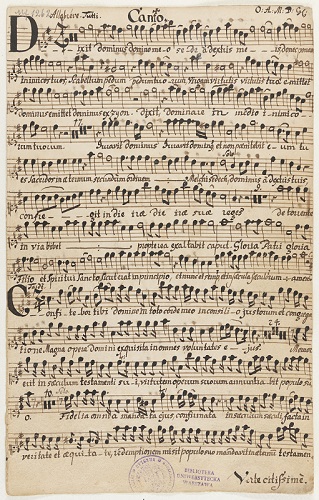A Numerical Riddle, or a Chronogram in a Musical Manuscript
Ewa Hauptman-Fischer
Thursday, June 22, 2023

We have received the following from Ewa Hauptman-Fischer (University of Warsaw Library, Music Department). It was originally published on the library’s blog and is reprinted here with kind permission.
Anonymous vespers—Vesperae ex D (PL-Wu, shelfmark RM 5265), held in the Music Department of the University of Warsaw Library, is one of many manuscripts belonging to the collection of music from the monastery of the Canons Regular of the Lateran in Wrocław (formerly Breslau). It contains a vocal-instrumental arrangement of vespers: the liturgy of evening prayer, one of the canonical hours, performed by Canons Regular in the 18th century, often with the participation of a musical ensemble. This manuscript is remarkable for containing a chronogram.
A chronogram is a letter and number game that was popular from the Middle Ages to the Baroque. In a chronogram, letters in a Latin sentence are written in such a way that they can simultaneously be interpreted as Roman numerals. Chronograms were mostly used to encode dates in short Latin texts. They can be found both in private writings and in printed editions.
In the present manuscript, the chronogram is found at the end of the soprano part (Canto). Instead of a signature and date, the copyist referred to the unusual events he witnessed at the time. He veiled the date in the following Latin phrase:

Laus Deo. 27 Januarij. Anno qvô strepentibus undique ensibus, fatalis lux erat cometa
We can translate this sentence as follows: “Praise the Lord. On January 27, the year in which – with the clash of swords coming from everywhere – the unfortunate light of the comet appeared”.
The capital letters denote Roman numerals. Adding them together will reveal a number that indicates the year in which the manuscript was written.
We leave the riddle for readers to figure out! Our advice: you can add the Roman numerals in the order they were written, or you start with the number with the highest value. You can also check the date in the RISM database (RISM ID no. 1001056844: RISM Catalog | RISM Online).
In that year, stunning comet tails appeared in the sky. The Klinkenberg – de Cheseaux comet, named after two independent researchers, was observed in Silesia at a difficult time for the region. From 1740, Silesia was a battleground between the Catholic Habsburg Monarchy and Protestant Prussia. The civilian population suffered acutely from the conflict; apart from fighting, they were plagued by war-related epidemics. It was during these turbulent times that the comet appeared in the sky – initially two tails were visible, later as many as six. We can only assume that the comet, which was a scientific challenge for astronomers, may have terrified an ordinary person. And this uncertainty and fear is reflected in the chronogram written down in a musical manuscript from the monastery of Canons Regular of the Lateran in Wrocław.
The observation of the spectacular comet visible with the naked eye was an unprecedented event at the time. The comet was commemorated with two medals struck in Silesia. The silver medal immortalised the comet with six tails in a starry winter sky – the date of the phenomenon is struck in the exergue. On the reverse of the medal there was a quotation from the Letter to the Romans: “WER HAT DES HERRN SINN ERKANNT?” (“Who has known the mind of the Lord?” Romans 11:34), which may indicate that the appearance of the comet was regarded as a supernatural and incomprehensible phenomenon.
The chronogram inscribed in the musical manuscript, although more ephemeral and less durable than a medal struck in silver, is as much a testimony to the reception of this extraordinary astronomical phenomenon as the aforementioned medal. The sight of the comet in the difficult times of war did not inspire optimism and frightened the copyist in the Canons Regular monastery in Wrocław. Fortunately, he continued to copy musical manuscripts, leaving the letter-number riddles to a present-day librarian. A date written in this way can break us out of our routine.
Image (top): Anonymous, Vesperae ex D, Canto (PL-Wu, RM 5265). RISM ID no. 1001056844 (RISM Catalog | RISM Online). Photographs: Bartłomiej Karelin.
Share Tweet EmailCatégorie: Collections de bibliothèques

